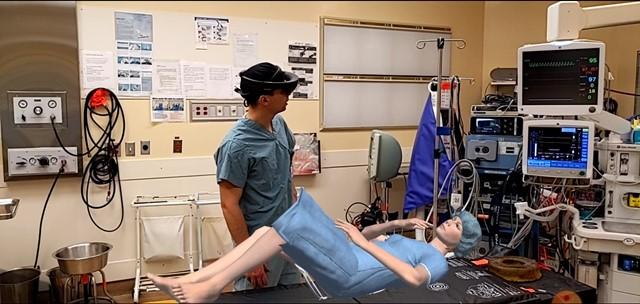In recent years, augmented reality (AR) has emerged as a transformative force across various industries, with medical education standing out as a particularly impactful area of innovation. By seamlessly blending digital details with teh physical world, AR offers unprecedented opportunities to enhance the training of healthcare professionals. This technology enables immersive, hands-on learning experiences that were once unimaginable, providing students and practitioners alike with safe, interactive environments to refine their skills. In this article, we explore how augmented reality is revolutionizing medical training, from anatomy visualization to surgical simulations, and discuss the potential it holds to improve patient outcomes and reshape the future of healthcare education.
Table of Contents
- Augmented Reality Enhancing Hands-On Learning Experiences in Medical Training
- Transforming Anatomical Education Through Immersive Visualization Techniques
- Integrating Augmented Reality Tools into Medical Curriculum for Improved Competency
- Best Practices for Implementing Augmented Reality Solutions in Healthcare Education
- to sum up
Augmented Reality Enhancing Hands-On Learning Experiences in Medical Training
Medical training has traditionally relied on textbooks, cadavers, and clinical observation, but augmented reality (AR) is now transforming how students and professionals acquire practical skills. By integrating interactive 3D anatomical models and real-time guidance directly into the learning surroundings, AR bridges the gap between theoretical knowledge and hands-on practice. Trainees can explore complex organ systems, simulate surgical procedures, and observe physiological processes with unprecedented clarity, which enhances comprehension and retention. This immersive approach not only boosts confidence but also minimizes risk by allowing repeated practice without patient involvement.
Several key advantages define AR’s impact on medical education, including:
- Personalized learning paths: Customizable modules accommodate individual skill levels, promoting efficient mastery of techniques.
- immediate feedback: Real-time corrections and performance analytics guide learners toward improvement.
- Collaboration opportunities: AR supports remote joint sessions, fostering teamwork and knowledge sharing across locations.
- Cost-effectiveness: Reducing dependency on physical resources and enabling scalable training scenarios.
Collectively, these benefits are reshaping medical education into a more dynamic, accessible, and effective domain.
Transforming Anatomical Education Through Immersive Visualization Techniques
Medical training is undergoing a profound transformation with the integration of immersive visualization techniques, especially augmented reality (AR). By bridging the gap between theoretical knowledge and practical experience, AR offers an unprecedented way to explore complex anatomical structures. Students and professionals can interact with three-dimensional, life-sized models that respond to touch and movement, promoting deeper understanding and retention of intricate bodily systems. unlike conventional textbooks or static models,these dynamic experiences allow for real-time manipulation,layer removal,and cross-sectional views,enriching the learning process beyond conventional boundaries.
Key benefits of immersive visualization in anatomical education include:
- Enhanced spatial awareness: Users can visualize organ systems in their true spatial relationships.
- Safe and repeatable practice: Students can rehearse complex procedures multiple times without risk to patients.
- Improved collaboration: AR platforms enable remote experts to guide learners in real-time.
- Personalized learning: Content can be tailored to individual needs, pacing, and knowledge levels.
As immersive visualization continues to integrate with medical curricula, it is setting new standards for competency and precision, ultimately enhancing patient care through better-trained practitioners.
Integrating Augmented Reality Tools into Medical Curriculum for Improved Competency
Implementing augmented reality (AR) tools into medical education offers a transformative approach to developing clinical skills with unmatched interactivity and precision. AR platforms allow students to visualize complex anatomical structures in three dimensions,providing a tactile understanding that traditional textbooks and 2D images simply cannot match. Such immersive technology promotes deeper cognitive engagement, enabling learners to repeatedly practice procedures in a risk-free environment. This hands-on experience not only enhances muscle memory but also refines decision-making abilities, critical for real-world patient care.
Moreover, AR integration into the curriculum encourages collaborative learning by facilitating real-time simulations, where students and instructors can interact with virtual patients and medical scenarios together.Key benefits include:
- Enhanced spatial awareness through life-sized 3D models.
- Immediate feedback during simulation exercises.
- Improved retention via multisensory engagement.
- Accessibility to rare case studies and conditions.
these advantages underscore AR’s potential to elevate medical competency, making the learning process both efficient and impactful for future healthcare professionals.
Best Practices for Implementing Augmented Reality Solutions in Healthcare Education
Successfully integrating augmented reality (AR) into healthcare education demands a strategic approach that prioritizes both technological capability and pedagogical effectiveness. Start by fostering collaboration between medical educators and AR developers to ensure the tools designed truly address curriculum needs. Scalability and adaptability should be at the forefront—select platforms that can evolve with emerging medical knowledge and adapt to various learning environments. Security and patient privacy considerations are crucial,requiring compliance with healthcare regulations like HIPAA when real patient data is involved.
Practical implementation also benefits from continuous feedback loops where students and instructors provide regular input to refine the AR experiences. Invest in extensive training for educators so that they can effectively facilitate AR sessions, turning technology into a seamless extension of their teaching rather than a distraction. Consider these guiding principles:
- Focus on immersive realism: The more authentic the simulations, the greater the retention and confidence among trainees.
- Ensure accessibility: Design AR content for diverse learning styles and abilities to maximize inclusion.
- Measure outcomes: Use analytics and assessment tools integrated with AR platforms to evaluate learning progress and tweak content accordingly.
In Conclusion
augmented reality is undeniably transforming the landscape of medical training by offering immersive, interactive, and highly detailed learning experiences. As this technology continues to evolve, it promises to enhance the proficiency and confidence of healthcare professionals, ultimately leading to improved patient care and outcomes. Embracing augmented reality in medical education is not just an innovation—it’s a vital step toward shaping the future of medicine. For educators and institutions ready to invest in cutting-edge solutions, the potential benefits are profound and far-reaching.

